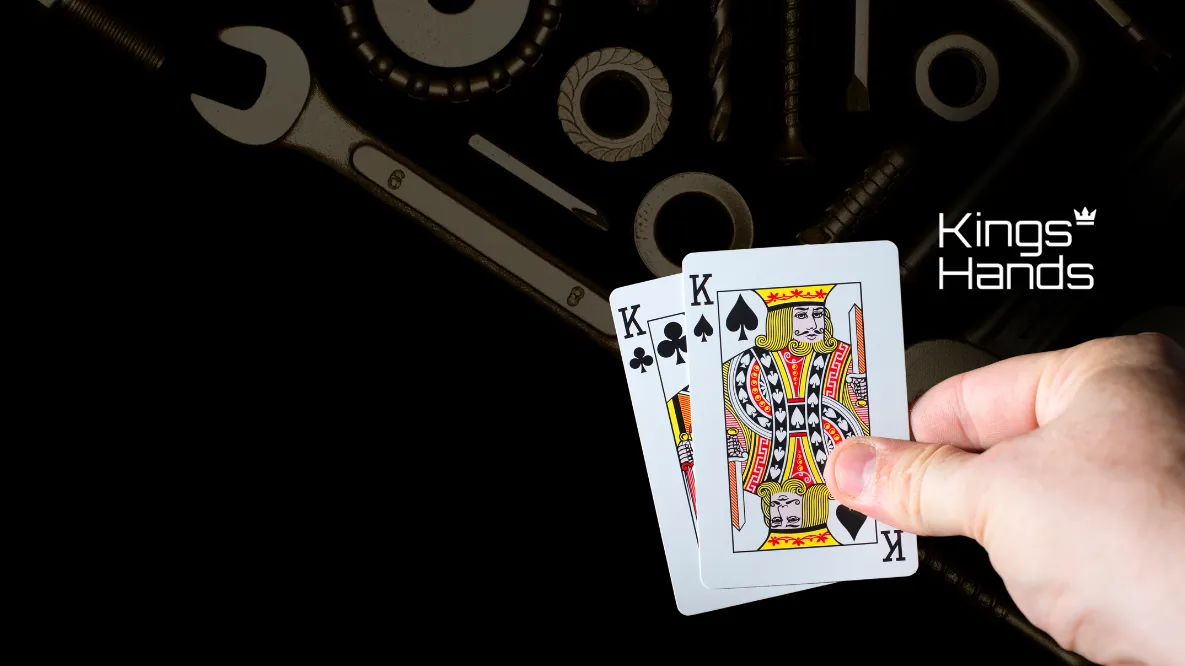There are few greater feelings in poker than flopping a set; seeing that third card hit the flop, knowing that you’re likely going to win a huge pot is what poker players live for. However, some players take things too far and call with every pocket pair, hoping to flop a set.
To help you avoid this mistake, we’ll be taking a look at how to calculate the EV of set mining, why it’s important, and more!
What Is Set Mining?
Set mining is the act of calling a preflop raise with a pocket pair with the explicit intention to flop a set. Low pocket pairs like 22-88 are often used for set mining, as they’re not considered strong enough to win the pot in their own right. Strong pocket pairs like AA-JJ aren’t used for set mining, as they’re strong enough to win the pot without improving.
Why Is It Important To Know The EV Of Set Mining?
Calculating the EV of set mining is important as it’s not inherently profitable to call with a pocket pair to try and flop a set. If the preflop bet is too large or your opponent’s remaining stack is too small, you won’t win enough to outweigh the times that you miss.
By working out the EV of your decision, you can avoid unprofitable situations, saving you money in the long run.
How Do We Calculate The EV of Set Mining?
Calculating the EV of set mining can be complicated, as there are many permutations that can happen; you can flop a set and get no value, flop a set and get one street of value, miss your set and lose, miss your set and win, and more!
However, to keep things simple, we’re going to focus on three permutations; you miss your set and lose, you hit your set and get no value, and you hit your set and stack your opponent. While this won’t give us the exact EV of calling with your pocket pair, it will be close enough for what we’re looking to accomplish.
Below, you can find the equation for calculating the EV of set mining, along with a breakdown of each variable.
Set mining EV = (0.12 * % Win Stack * $ Won) + (% Fold * Pot Size) – (0.88 * Preflop Call)
0.12 – The percentage of the time we make our set
% Win Stack – The percentage of the time we stack our opponent after making our set
$ Won – How much we win when we stack our opponent
% Fold – How often our opponent folds after making our set
Pot Size – The size of the pot on the flop minus our preflop call
0.88 – The percentage of the time we don’t make our set
Preflop Call – How much we have to call preflop
Looking at the equation like this makes it more complicated than it really is, so let’s take a look at a real-world example and see how it would work.
You’ve raised to $6 in a $1/$2 cash game with 33 and your opponent in the big blind has 3-bet to $20. They have $180 behind and you’re debating whether or not you should call. You don’t think your 33 is likely to win at showdown, so you want to determine the EV of set mining against this 3-bet.
Given the preflop 3-bet, you think your opponent has a strong range, so you think you’ll win your opponent’s stack 60% of the time when you do flop your set. Let’s see how this situation plays out when we input these variables into our equation.
Remember, when calculating the EV of set mining in a 3-bet pot, you can take your original raise amount and put it into the pot size as it is considered dead money. Similarly, our preflop call becomes $14 rather than $20, as you already have $6 invested.
Set mining EV = (0.12 * 0.6 * $180) + (0.12 * 0.4 * $27) – (0.88 * $14)
Set mining EV = $12.96 + $1.30 – $12.32
Set mining EV = $1.94
As you can see, the EV of calling to try and hit a set in this situation would be $1.64, meaning that we have a profitable call.
When calculating the EV of set mining, it’s important to try and be as accurate as possible when estimating how often your opponent will stack off when you flop your set. Changing this variable will drastically change the EV of your call; for example, let’s take a look at our previous scenario when we change the percentage of the time our opponent stacks off from 60% to 40%.
Set mining EV = (0.12 * 0.4 * $180) + (0.12 * 0.6 * $27) – (0.88 * $14^)
Set mining EV = $8.64 + $1.94 – $12.32
Set mining EV = -$1.74
Just by reducing the frequency our opponent stacks off from 60% to 40%, our EV goes from positive to negative.
Arguably the most important variable to consider is your opponent’s remaining stack size. If they don’t have enough money to win, your set mine will never be profitable. Let’s look at an example where our opponent stacks off 75% of the time, but they only have $80 behind instead of $180.
Set mining EV = (0.12 * 0.75 * $80) + (0.12 * 0.25 * $27) – (0.88 * $14^)
Set mining EV = $7.20 + $0.81 – $12.32
Set mining EV = -$4.31
In this scenario, the EV is considerably lower, despite the increased stack-off percentage!
Set Mining EV In Action
Poker professionals use set mining EV all the time in their games to determine the profitability of calling with their pocket pair. Let’s take a look at one in action; our example comes from the Pokerstars Big Game where Lex Veldhuis and Doyle Brunson faced off in a hand.
The action folds around to Doyle with who raises to $1,600 and Lex is in the big blind with and is considering the call. He has to call another $1,200 into a pot of $2,600 (there is a big blind ante in The Big Game) and he knows that Doyle likes to play tight on TV cash games. Doyle has around $145,000 behind and Lex likely thinks he can stack Doyle 10% of the time when he makes his set.
Given those variables, let’s look at our equation.
Set mining EV = (0.12 * 0.1 * $145,000) + (0.12 * 0.9 * $2,600) – (0.88 * $1,200)
Set mining EV = $1,740 + $280.80 – $1,056
Set mining EV = $964.80
After running the numbers, Lex sees that he has a hugely profitable call with his 55, so he makes the call. Lex managed to flop his set while Doyle flopped a flush draw. Lex boated up on the turn and got all the money in with Doyle drawing dead.
Set Mining EV Quiz
Now that we understand how to calculate the EV of set mining, let’s put your knowledge to the test with a short quiz! You will find the answers at the bottom of the page.
Question 1
You’re on the button with 44 in a $1/$2 cash game facing a preflop raise to $10 from UTG. You assume that you will win your opponent’s $190 stack 20% of the time when you flop your set. Is it profitable to set mine in this scenario?
Question 2
You’ve raised to $8 with 22 in a $1/$2 cash game and face a 3bet from the small blind to $16. Your opponent has $114 behind and you think you’ll stack them 40% of the time. What is the EV of set mining in this scenario?
Question 3
You’ve raised to $10 with 55 in a $1/$2 cash game and your opponent in the SB has 3bet to $31. They have $324 behind and you believe they’ll stack off 40% of the time. Would this scenario be more or less profitable than a situation where they had $264 behind and stacked off 55% of the time?
Summary
Calculating the EV of set mining is an important tool used by poker players to ensure they’re making profitable decisions. It’s not always profitable to call to try and hit a set, and by running these set mining calculations, you can determine the EV of calling to flop your set. With this information, you’ll be able to avoid making unprofitable set mining decisions in your game!
Answers:
Question 1 – It is not profitable to set mine in this situation as the EV is -$2.99.
Question 2 – The EV of set mining in this scenario is $0.43.
Question 3 – The first scenario has an EV of $0.17 and the second scenario has an EV of $1.26, making the second scenario the more profitable of the two.





















